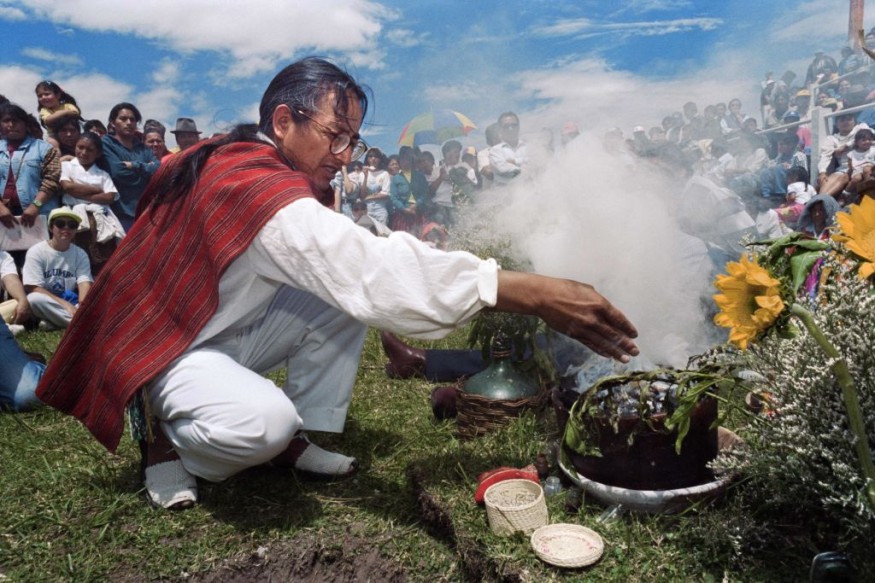Ecuador: History of Ecuadorian Tradition, Inti Raymi

Much like many ancient civilizations in Ecuador, the Incas held the sun and moon in high regard, attributing great importance to solstices and equinoxes, according to Happy Gringo.
Among these significant dates, none were more revered than Inti Raymi, the summer solstice.
These sacred occasions are celebrated in present-day Ecuador through vibrant and colorful festivals, especially within indigenous communities. Tourist visitors are often welcome to partake in the festivities.
Inti Raymi, the festival of the sun observed during the summer solstice, stands out as the most well-known event in the annual indigenous calendar.
This presents a wonderful opportunity for individuals to delve into Ecuadorian Indian culture and traditions, interact with the locals, and even partake in homestays within indigenous communities.
The celebration of Inti Raymi allows for a rich cultural exchange and an immersive experience in the heart of Ecuador's indigenous heritage.
READ NEXT : Top 5 Festivals in Peru
Inti Raymi: A Brief History
Inti Raymi, which translates to "Festival of the Sun" in the Quechua language, has deep roots that extend back centuries to the Inca civilization, per Andean Travel Company.
This sacred ceremony was held annually, honoring Inti, the Sun God, and celebrating the winter solstice.
The historical significance of Inti Raymi is profound, encompassing its origins, rituals, and cultural importance for the Inca Empire.
In the Inca civilization, Inti Raymi was a yearly religious ceremony to pay homage to Inti, the Sun God.
This grand celebration occurred during the winter solstice, typically in June, and spanned 15 days marked by captivating dances and symbolic sacrifices.
According to historical chronicles, a key ritual involved the Inca kneeling with arms open, welcoming the sun's rays during the ceremony.
Holding a golden cup in his left hand, he would offer chicha, a traditional corn-based beverage, to family members while pouring chicha into a golden jar with his right hand.
Local leaders presented their offerings, and the main priest ignited the ceremonial fire to kickstart the festivities.
The meat from sacrificial animals was shared among all attendees, fostering a communal spirit.
During the colonial era in Ecuador, Inti Raymi faced restrictions, as Spanish authorities considered it a pagan celebration.
Despite these constraints, it continued to be clandestinely practiced. Only in recent years has Inti Raymi re-emerged as a public event, becoming a showcase of Ecuador's cultural heritage.
In locations such as Ingapirca, the country's most significant Inca archaeological site, Inti Raymi is celebrated enthusiastically, drawing both locals and tourists to participate in this vibrant and historic event.
How Ecuador Celebrates Inti Raymi?
Inti Raymi initiates with the sacred Armay Chisi, a ritual bathing ceremony aimed at spiritual purification, energy cleansing, and renewing connections to Pacha Mama (Mother Earth).
Indigenous communities gather by local water sources at midnight, stripping down to immerse themselves in cold waters, symbolizing a profound spiritual rebirth.
Inti Raymi is accompanied by lively festivities in the vibrant tapestry of Ecuadorian celebrations.
Local musicians play Kichwa songs daily, and communal dances invite everyone to participate.
Participants stomp their feet to attract Pacha Mama's attention. At the same time, Aya Uma, portrayed by a respected community member, leads the dance.
Recognizable by a mask with two faces symbolizing day and night and fabric snakes representing wisdom, Aya Uma embodies Andean cultural significance.
Festivities often extend into the early hours, featuring locally crafted potent alcohol, with tourists encouraged to join the dance, embodying the spirit of "if you can't beat them, then join them."
At its essence, Inti Raymi is a celebration of harvest and abundance, with food playing a central role.
The Pampamesa, translating to "Food for All," is a communal experience. A fabric strip or ponchos on the ground is adorned with staple foods like corn, potatoes, and pork.
Chicha, a local corn-based moonshine, flows freely. This communal feast, where all contribute and partake, fosters a deep sense of community and connection to Mother Nature.
Ecuadorian indigenous pride is evident in their clothing traditions, showcasing unique fabrics and hats specific to each community and region.
Men wear chaps made from sheep hides, a symbolic nod to the indigenous reclaiming control of the land.
Indigenous women don vibrant dresses and jewelry during the dance, contributing to the vibrant and culturally rich atmosphere of Inti Raymi.
Read also: Ecuador: Top 5 Tourist Spots
This article is owned by Latin Post.
Written by: Bert Hoover
WATCH: Ecuador's Indigenous Celebrate Inti Raymi Sun Festival - From TeleSUR English
Subscribe to Latin Post!
Sign up for our free newsletter for the Latest coverage!
















